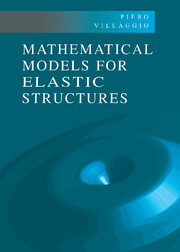Book contents
- Frontmatter
- Contents
- Preface
- Introduction
- Chapter I Basic Concepts
- Chapter II Rod Theories: Three-dimensional Approach
- Chapter III Rod Theories: Director Approach
- Chapter IV Theories of Cables
- Chapter V Theories of Membranes
- Chapter VI Theories of Plates
- Chapter VII Theories of Shells
- References
- Index of Authors Cited
- Index
Preface
Published online by Cambridge University Press: 11 September 2009
- Frontmatter
- Contents
- Preface
- Introduction
- Chapter I Basic Concepts
- Chapter II Rod Theories: Three-dimensional Approach
- Chapter III Rod Theories: Director Approach
- Chapter IV Theories of Cables
- Chapter V Theories of Membranes
- Chapter VI Theories of Plates
- Chapter VII Theories of Shells
- References
- Index of Authors Cited
- Index
Summary
Few words are used with so many different meanings as the term “model.” In everyday language the word “model” can be applied in a moral, fashion, economic, linguistic, or scientific context; in each case it means something completely different. Even if we restrict ourselves to the category of scientific models, the notion is ambiguous, because it could signify the reproduction in miniature of a certain physical phenomenon, and at the same time present a theoretical description of its nature that preserves the broad outline of its behavior. It is the theoretical aspect of models that we wish to consider; in order to emphasize this, we describe this type of model as “mathematical” (Tarski 1953). Formulating a mathematical model is a logical operation consisting in: (i) making a selection of variables relevant to the problem; (ii) postulating statements of a general law in precise mathematical form, establishing relations between some variables said to be data and others unknown; and (iii) carrying out the treatment of the mathematical problem to make the connections between these variables explicit.
The motivations underlying the use of mathematical models are of different types. Sometimes a model is the passage from a lesser known theoretical domain to another for which the theory is well established, as, for example, when we describe neurological processes by means of network theory. In other cases a model is simply a bridge between theory and observation (Aris 1978). The word “model” must be distinguished from “simulation.” The simulation of a phenomenon increases in usefulness with the quantity of specific details incorporated, as, for example, in trying to predict the circumstances under which an epidemic propagates. The mathematical model should instead include as few details as possible, but preserve the essential outline of the problem. The “simulation’ is concretely descriptive, but applies to only one case; the “mathematical model” is abstract and universal. Another special property of a good mathematical model is that it can isolate only some aspects of the physical fact, but not all. The merit of such a model is not of finding what is common to two groups of observed facts, but rather of indicating their diversities. A long-debated and important question is that of how to formulate a model in its most useful form.
- Type
- Chapter
- Information
- Mathematical Models for Elastic Structures , pp. ix - xiiPublisher: Cambridge University PressPrint publication year: 1997



